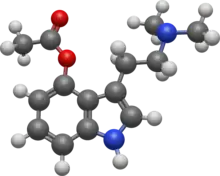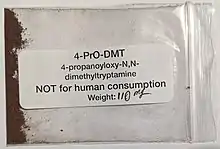4-PrO-DMT
4-Propionoxy-N,N-dimethyltryptamine (4-PrO-DMT, or O-Propionylpsilocin) is a synthetic psychedelic drug from the tryptamine family with psychedelic effects, and is theorized to act as a prodrug for psilocin. It has been sold online as a designer drug since May 2019. It was first identified as a new psychoactive substance in Sweden, in July 2019.[1]
 | |
 | |
| Clinical data | |
|---|---|
| Other names | 4-Propanoyloxy dmt |
| Identifiers | |
IUPAC name
| |
| CAS Number | |
| PubChem CID | |
| ChemSpider | |
| UNII | |
| Chemical and physical data | |
| Formula | C15H20N2O2 |
| Molar mass | 260.337 g·mol−1 |
| 3D model (JSmol) | |
SMILES
| |
InChI
| |
Recreational use

Dosage
4-PrO-DMT is reported to be orally active, though its threshold and duration are unstudied.
Effects
The effects of 4-PrO-DMT are broadly comparable to those of other serotonergic psychedelics such as LSD and psilocybin.
Pharmacology
Pharmacodynamics
4-PrO-DMT is theorized to be a serotonergic psychedelic, and is partial agonist of the 5-HT1D, 5-HT1B and 5-HT1A serotonin receptors.
Similar to 4-AcO-DMT, 4-PrO-DMT is believed to be a pro-drug of psilocin.
Toxicity
Very little data about the toxicity or pharmacology of 4-PrO-DMT is known. Its chemical structure and pharmacological activity are similar to psilacetin, a compound which isn't associated with compulsive use or physical dependence. However, due to lack of research and data, it cannot be definitively concluded that its pharmacological actions in the human body do not differ from those of psilacetin. To date, there have been no reported deaths from 4-PrO-DMT.
See also
References
- European Monitoring Center for Drugs and Drug Addiction (December 2020). New psychoactive substances: global markets, glocal threats and the COVID-19 pandemic. An update from the EU Early Warning System (PDF). Luxembourg: Publications Office of the European Union. doi:10.2810/921262. ISBN 9789294975584.
Serotonin receptor modulators | |||||||||||||||||||||||||||||||||||||||
|---|---|---|---|---|---|---|---|---|---|---|---|---|---|---|---|---|---|---|---|---|---|---|---|---|---|---|---|---|---|---|---|---|---|---|---|---|---|---|---|
| 5-HT1 |
| ||||||||||||||||||||||||||||||||||||||
| 5-HT2 |
| ||||||||||||||||||||||||||||||||||||||
| 5-HT3–7 |
| ||||||||||||||||||||||||||||||||||||||
| |||||||||||||||||||||||||||||||||||||||